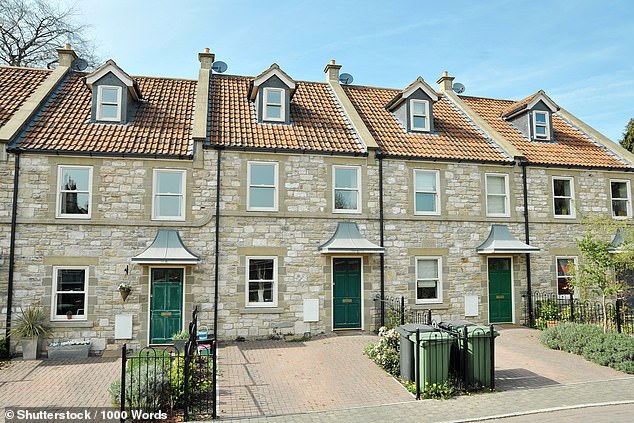
House prices rose for the fifth month in a row in June, according to the latest figures from the Office for National Statistics.
The average house price was up 2.7 per cent, with the typical home selling for around £288,000.
In cash terms, it means the average house price jumped £8,000 compared to 12 months earlier.
The ONS figures run on a delay compared to other house price indexes, but are considered more accurate because they are based on completed sales.

On the up: On an annual basis, average prices are rising in every region of the UK
The average home jumped 0.5 per cent between May and June alone, with property values in Northern Ireland and Yorkshire and the Humber leading the charge.
Marc von Grundherr, director at Benham and Reeves estate agents said: ‘Five consecutive months of positive monthly house price growth demonstrates that the UK property market is very much bouncing back from the period of stagnation caused by higher mortgage rates.
‘Buyers are acting with greater confidence and this confidence will only grow all the stronger now that interest rates are starting to fall and so we expect to see a very strong end to the year, both in terms of buyer activity levels and the resulting boost to property values.’
Lower mortgage rates drive house prices higher
Falling mortgage rates are thought to be the big factor helping to revive house prices.
The Bank of England cut base rate from 5.25 per cent to 5 per cent at the start of the month and this sparked a wave of mortgage rate reductions with a number of lenders now offering five-year fixed rate deals below 4 per cent.
However, today’s house price figures came alongside news that inflation has risen back above the Bank of England’s inflation target to 2.2 per cent.
This means the average price of goods and services are now 2.2 per cent higher than it was last year.

Mortgage rates dipping: Lower mortgage rates are encouraging more would-be buyers to act
However, this was a smaller than expected rise with economists and commentators quick to point out that it should have little bearing on the direction of interest rates.
Peter Stimson, head of product at MPowered Mortgages said: ‘Even though inflation has risen, there is unlikely to be an impact on mortgage rates as this has already been priced in.’
Where are house prices rising most?
Every region of the UK has seen house prices rise compared to 12 months ago.
Over 12 months to June, Northern Ireland has seen prices rise by 6.4 per cent on average, while in Scotland house prices are up 4.3 per cent.
Meanwhile England and Wales have recorded more modest house price growth of 2.4 per cent and 1.8 per cent year-on-year respectively.
However, the monthly picture reveals differences. Northern Ireland saw house prices jump 3.6 per cent over the past month, while Yorkshire and The Humber saw prices go up 2.7 per cent.
However, average home values in the East Midlands fell by 0.5 per cent and in the South West of England prices fell by 1 per cent between May and June.
The type of property also has a bearing on house prices. For example, semi-detached homes are up 4 per cent over the past 12 months, rising from £269,998 to £280,895.
However, the average price of a flat or maisonette has only risen by 0.5 per cent during that time.
Jonathan Hopper, chief executive of buying agent, Garrington Property Finders, said: ‘National averages tend to mask some of the disparities created when you have an increasing number of keen, but acutely price sensitive, buyers.
‘Price rises are currently strongest in areas seen as offering very strong value, but the least affordable areas are still seeing only modest price growth.
‘Even in traditionally prime areas, only the very best properties are achieving full asking prices.’
How accurate is ONS house price data?
The ONS house price data broadly aligns with what we are seeing in both Nationwide and Halifax’s house price figures, based on their mortgage data.
Halifax said house prices were up by 2.3 per cent year-on-year, which is the highest it has been in 2024 so far.
Nationwide said house prices were up by 2.1 per cent in the 12 months to July – this is the biggest annual rise it has recorded over the past 18 months.

Game changer: The Bank of England cut the base rate from 5.25% to 5% on 1 August
However, the ONS data lags other sets of house price data as it relies on sold prices from the Land Registry.
This means it’s showing the prices paid in the month before the general election and long before this month’s cut in the Bank of England base rate.
Buying agent, Jonathan Hopper suggests there may be further house price gains to come over the next few months given there has been an uptick in buying interest.
He said: ‘ONS data is more than a little sepia-tinted and doesn’t reflect the subsequent upswing in buyer sentiment.
‘Buyer enquiries have picked up and the market has got busier even if the summer holiday means it’s still running at far less than top speed.
‘Crucially, the cost of borrowing has started to come down following the Bank of England’s decision a fortnight ago.
‘Thousands of would-be buyers who put their moving plans on hold for months, or even years, are now asking themselves ‘if not now, then when?’
Some links in this article may be affiliate links. If you click on them we may earn a small commission. That helps us fund This Is Money, and keep it free to use. We do not write articles to promote products. We do not allow any commercial relationship to affect our editorial independence.
